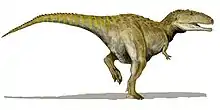Huincul Formation
The Huincul Formation is a geologic formation of Late Cretaceous (Early Cenomanian to Late Turonian) age of the Neuquén Basin that outcrops in the Mendoza, Río Negro and Neuquén Provinces of northern Patagonia, Argentina.[1] It is the second formation in the Río Limay Subgroup, the oldest subgroup within the Neuquén Group. Formerly that subgroup was treated as a formation, and the Huincul Formation was known as the Huincul Member.[2]
| Huincul Formation Stratigraphic range: Mid Cenomanian-Late Turonian ~97–93 Ma | |
|---|---|
| Type | Geological formation |
| Unit of | Neuquén Group Río Limay Subgroup |
| Underlies | Lisandro Formation |
| Overlies | Candeleros Formation |
| Thickness | 250 m (820 ft) |
| Lithology | |
| Primary | Sandstone |
| Other | Claystone |
| Location | |
| Coordinates | 39.4°S 69.0°W |
| Approximate paleocoordinates | 46.1°S 46.0°W |
| Region | Mendoza, Río Negro & Neuquén Provinces |
| Country | |
| Extent | Neuquén Basin |
| Type section | |
| Named for | Plaza Huincul |
| Named by | Keidel |
| Year defined | 1929 |
 Huincul Formation (Argentina) | |
Description
The type locality of the Huincul Formation is near the town of Plaza Huincul in Neuquén Province after which the formation was named by Wichmann in 1929.[3] This formation conformably overlies the Candeleros Formation, and it is in turn overlain by the Lisandro Formation.
The Huincul Formation is thought to represent an arid environment with ephemeral or seasonal streams.[4] In some areas, it is up to 250 metres (820 ft) thick. It is mainly composed of green and yellow sandstones and can easily be differentiated from the overlying Lisandro Formation, which is red in color. The Candeleros Formation, underlying the Huincul, is composed of darker sediments, making all three formations easily distinguishable.[2][5]
Fossil content
Fossil bones are rarely found in the Huincul Formation. However, remains of Argentinosaurus huinculensis, one of the largest land animals known, were found in the Huincul Formation, and this species is named after it.[2] One of the largest predators known, Mapusaurus, has also been recovered from a bonebed in this formation.[4]
Fossils found in the Huincul Formation include those of dinosaurs:
- several titanosaurian sauropods (including Argentinosaurus and Choconsaurus)
- rebbachisaurid sauropods (including Cathartesaura and Limaysaurus)
- carcharodontosaurid theropods (including Mapusaurus and an unnamed form)[6]
- a neovenatorid theropod (Gualicho)
- a megaraptoran theropod (Aoniraptor)
- several abelisaurid theropods (including Skorpiovenator, Tralkasaurus and Ilokelesia)
- an elaphrosaurine theropod (Huinculsaurus)
- a paravian theropod (Overoraptor)
- several iguanodonts
- ichnofossils of abelisaurids and hadrosaurids[7]
See also
- List of fossil sites
- List of dinosaur bearing rock formations
References
- Huincul Formation at Fossilworks.org
- Sánchez et al., 2006
- Wichmann, 1929
- Coria & Currie, 2006
- Leanza et al., 2004, p.68
- Canale et al., 2012
- Leonardi, 1994, p.30
Bibliography
- Canale, Juan Ignacio; Sebastián Apesteguía; Peter Makovicky; Pablo Ariel Gallina; Federico Gianechini; Natan Smith; Ignacio Maniel, and Alejandro Haluza. 2012. New carcharodontosaurid theropod remains from El Chocón Neuquén Group, Huincul Formation, Neuquén, Argentina. Ameghiniana 50. .
- Coria, R.A., and P.J. Currie. 2006. A new carcharodontosaurid (Dinosauria, Theropoda) from the Upper Cretaceous of Argentina. Geodiversitas 28. 71–118. Accessed 2019-02-16.
- Leanza, H.A.; S. Apesteguia; F.E. Novas, and M.S. De la Fuente. 2004. Cretaceous terrestrial beds from the Neuquén Basin (Argentina) and their tetrapod assemblages. Cretaceous Research 25. 61–87. Accessed 2019-02-16.
- Leonardi, Giuseppe. 1994. Annotated Atlas of South America Tetrapod Footprints (Devonian to Holocene) with an appendix on Mexico and Central America, 1–248. Ministerio de Minas e Energia - Companhia de Pesquisa de Recursos Minerais, Geological Service of Brazil. Accessed 2019-03-25.
- Sánchez, María Lidia; Susana Heredia, and Jorge O. Calvo. 2006. Paleoambientes sedimentarios del Cretácico Superior de la Formación Plottier (Grupo Neuquén), Departamento Confluencia, Neuquén (Sedimentary paleoenvironments in the Upper Cretaceous Plottier Formation (Neuquen Group), Confluencia, Neuquén). Revista de la Asociación Geológica Argentina 61. 3–18. Accessed 2019-02-16.
- Wichmann, R. 1929. Los Estratos con Dinosaurios y su techo en el este del Territorio del Neuquén ("The dinosaur-bearing strata and their upper limit in eastern Neuquén Territory"). Dirección General de Geología, Minería e Hidrogeología Publicación 32. 1–9.


